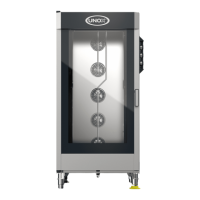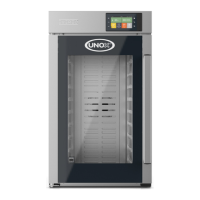Closed loop system
T
sp
< 60 °C (140 °F) 10%
60°C (140 °F)≤ T
sp
< 70°C (158 °F) 20%
70°C (158 °F)≤ T
sp
< 80°C (176 °F) 30%
80°C (176 °F)≤ T
sp
< 90°C (194 °F) 50%
90°C (194 °F) ≤ T
sp
< 100°C (212 °F) 70%
100°C (212 °F)≤ T
sp
< 120°C (248 °F) 100%
120°C (248 °F)≤ T
sp
< 140°C (284 °F) 50%
140°C (284 °F)≤ T
sp
< 240°C (464 °F) 30%
T
sp
≥ 240°C (464 °F) 20%
For instance, at 110°C (230 °F), if you set the STEAM.MAXI™ to 50%, the steam production is 50% of
the maximum available. At 85°C (185 °F) instead, it means that the real steam production will be 25%.
Speed motor Limitation
The speed of the motor limits the quantity of steam that can be produced, as shown in . At lower
speeds the quantity of water that can be vaporized by the fans is lower than at maximum speed.
Speed motor Limitation
Speed Limit factor
1 30%
2 50%
3 80%
4 100%
MULTI.Time
TM
Limitation
If a MULTI.Time
TM
program is running and there are no timer activated the oven limits the injection of steam
to 10%.
The timing of the DRY.Maxi™ valve meets the data reported in
Table 8
. Every time the humidity
measurement is greater than 30%, the DRY.Maxi™ setting of the table above is increased by 20%. After
this first adjustment, every time the humidity reading is less than 30% the DRY.Maxi™ is reduced by
20%.
If the DRY.Maxi™ is set to 100%, the DRY.Maxi™ solenoid actuator is always open.
First step of DRY .Maxi™/ STEAM.Maxi™
In order to activate/deactivate the DRY.Maxi™ or STEAM.Maxi™ system according to the real climate
conditions of the cooking chamber, a first measurement of humidity is required. Since this first humidity
reading is done after running the oven for 20 seconds, in the first 20 seconds the DRY.Maxi™ or
STEAM.Maxi™ technolgy works in open loop system, except when STEAM.Maxi™ is set to 100%. In this
case the setting of STEAM.Maxi™ switches to 40%.
Limitations
Temperature is the limiting factor for maximum steam productions as shown below in Table 9.
Temperature Limitation
According to the Temperature Set Point there is a limit of the steam production, as shown in Table 9.
The aim is to prevent the steel of the cooking chamber from any thermal shocks and to reduce the
quantity of water injected at low temperature since the production of steam is quite limited in that
condition.
Table 9
Temperature Limitation on the steam production

